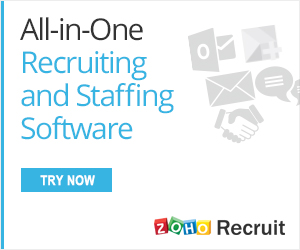Finding Your Way Through the Metrics Maze

The measurement and reporting of metrics might not exactly be a maze if you are simply relying on those provided by software such as an ATS, but the truly effective measurement and application of metrics entails more than clicking “Print”.
A special thank you goes out this month’s Leadership Sponsor, Zoho Recruit. Please visit their site to understand how their quality services can elevate your recruitment practices.
Those who really dive into metrics could be misplacing their resources by not starting off with a strategic understanding of which metrics are truly relevant to their organization. Beyond what metrics you should be measuring, there is also the factor of time frames –metrics from the past, present and those that are used to predict –to be considered.

Choose Wisely
Depending on who you ask, there can be anywhere from 3 to 20-something “vital” metrics in recruiting. The measurement and reporting of every recruiting metric out there alone would bog down the recruiting department to the point of rendering such data useless. If there is only time for measuring and reporting, no real action can be taken. Recruiters have to choose wisely.
So therein lies the question –How do I know which metrics I should be tracking and reporting? There are several metrics that fall under a general consensus among HR practitioners, including but not limited to the following:
Time-to-Fill
This metric is used to track the amount of time it takes from the job listing going live, to when the candidate starts. This doesn’t reflect when they accept an offer, but rather when they actually start. Each day that goes by with an unfilled position, the organization is either losing money, or a key business issue is not being addressed. So obviously, the faster the better, but quality of hire cannot suffer. The relationship between time-to-fill and quality of hire (or employee performance) should be monitored, as these correlations are important in achieving the right balance.
“You will find this data critical in measuring the productivity of your recruiting staff as well as determining which employee recruiting sources are working best. Are your recruiting efforts delivering good hires in a reasonable time for a good return on your investment?”
-Barry Shamis
Employee Performance
In business, every expense is tracked, as is the return on that expense. The employee performance metric is intended to track the organization’s return on their investment in human capital. Without this metric, employees are merely an expense to the organization. Tracking performance highlights your quality sources of hire, and helps to identify key talent within the organization so that they can be fostered and retained.
Turnover/Retention
Both voluntary turnover, and terminations are two of the most important metrics you can track. Because turnover is so costly (as high as 150% of annual salary ), it is crucial to track who left, why, what the cost was and even where they went. Revenue losses from turnover are represented in several ways that aren’t always immediately apparent like: recruiting costs, interviewing costs, training costs, lost knowledge, lowered productivity and an overworked remaining staff. Transversely, you need to know what keeps people with the organization (retention rates) so these attributes, perks or behaviors will continue in an effort to keep employees engaged and with the organization.
Source Quality
Any great recruiter is going to be working with several different avenues or pipelines to fill their talent needs. It is important to create a scoring system for each placement made from these talent sources. In this way, recruiters can identify their strongest and weakest sources of talent and reallocate or prioritize resources accordingly.
Cost of Hire
This is another of the more vital metrics in recruiting for obvious reasons. The cost of hire is comprised of obvious expenses, and those less tangible expenses; they all affect the bottom line though. Here you have to look deeper than those obvious expenses like job board postings, staffing services and background check fees. You have to get more granular and calculate the time/cost of your recruiting team’s time and effort for each placement.
Timing is Everything
“How did we do?” –The question that a lot of recruiters and hiring managers believe metrics will answer, and it does, but is that the right question? Is that the only question? What about “How are we doing?” Or “What should we do?”
There are three very distinct periods of time for every metric in recruiting according to HR thought-leader, Dr. John Sullivan :
- Historical Metrics –This data reflects what has already happened.
- Real-Time Metrics – This data reflects what has recently happened, or what is currently happening.
- Predictive Metrics –This data is used to prepare for the future.
Most HR practitioners who have the resources and knowledge to dive into their metrics are stuck in the past, studying their historical metrics. This tunnel vision on historical metrics is unfortunate, as Sullivan has deemed this data as the least useful of the three.
“Historical metrics are backward looking because they rely on data from last year. They many times cannot be reported in real time because the data for the metric cannot be measured at the time of application or hire. Because you need to wait till the end of the year in order to get these metrics, they cannot be generally used for day-to-day decision-making.”
-Dr. John Sullivan
Real-time metrics are considered far more effective, and predictive metrics can have the highest impact of the three, as they allow for pro-action and preparation. That is to say, these are metrics that provide the opportunity to create a real impact moving forward.
When considering which metrics to study and report on, it is crucial to take into account timing, and its impact on the effectiveness and relevancy of each metric. Have an understanding of which metrics are relevant to those whom they are being reported to, and why. Recruitment metrics used for internal improvements will be very different from those you report to executives and hiring managers.
Without a strategy around how you measure, report and act upon metrics, you’re probably just throwing another disjointed, ineffective process in the mix. Recruiters have enough of those. We all want to hire better people, for less money and in less time. Each of those needles isn’t going to make drastic movements in the right direction without a solid recruiting metrics strategy.
A special thank you goes out this month’s Leadership Sponsor, Zoho Recruit. Please visit their site to understand how their quality services can elevate your recruitment practices.

